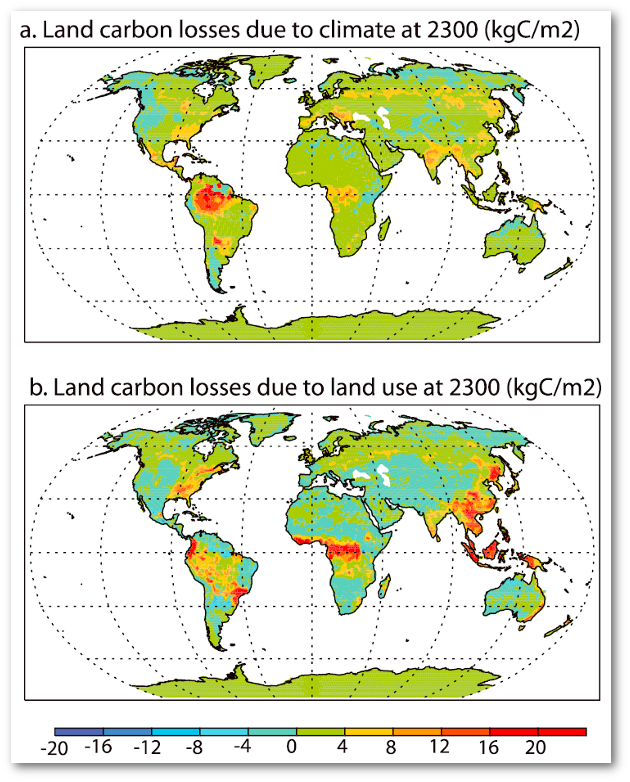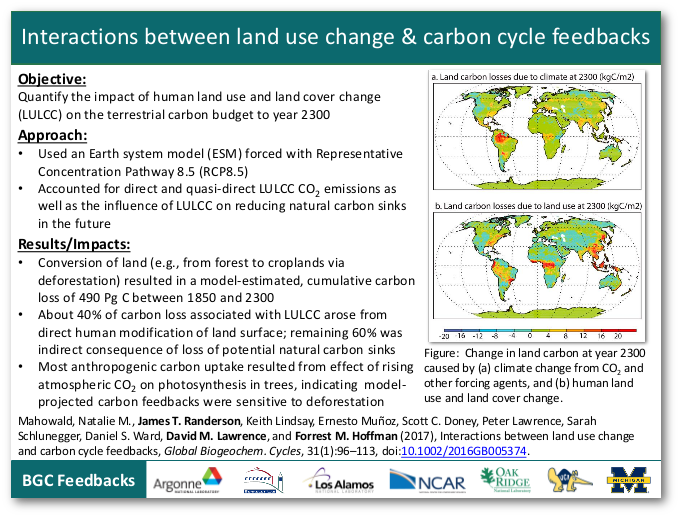Research Highlights
Interactions between land use change and carbon cycle feedbacks
January 23, 2017
Analysis of direct, quasi-direct, and indirect impacts of land use and land cover change (LULCC) on the terrestrial carbon budget to year 2300
The Science
Using an Earth system model (ESM), we explored the role of human land use and land cover change (LULCC) in modifying the terrestrial carbon budget in simulations forced by the Representative Concentration Pathway 8.5 (RCP8.5), extended to year 2300. We accounted for the direct and quasi-direct LULCC CO2 emissions, as well as the influence of LULCC on reducing natural carbon sinks in the future.
The Impact
The conversion of land (e.g., from forest to croplands via deforestation) resulted in a model-estimated, cumulative carbon loss of 490 Pg C between 1850 and 2300, larger than the 230 Pg C loss caused by climate change over the same interval. About 40% of the carbon loss associated with LULCC arose from direct human modification of the land surface; the remaining 60% was an indirect consequence of the loss of potential natural carbon sinks. Most anthropogenic carbon uptake in the model occurred from the influence of rising atmospheric CO2 on photosynthesis in trees, and thus, model-projected carbon feedbacks were especially sensitive to deforestation.
Summary
Human land use and land cover change (LULCC) contributes to anthropogenic climate change, accounting for approximately 10–15% of the atmospheric increase in CO2 concentrations and for about 40% of the total radiative forcing including other heat-trapping gases. In addition to the effects of deforestation and harvesting on CO2 emissions, LULCC also changes the surface albedo and biophysical properties of the land surface, increases emissions of methane and nitrous oxide, and alters aerosol emissions. For the first time, we used simulations from a full-complexity ESM to isolate the influence of LULCC on the evolution of the land carbon flux in simulations that extended from 1850 to 2300. Using a business-as-usual scenario, our simulations accounted for effects of LULCC and interactions with the climate system. Because of the multi-century carbon cycle legacy of current land use decisions, a globally averaged amplification factor of 2.6 was found to be required to apply to 2015 land use carbon losses to adjust for indirect effects. This estimate was 30% higher when considering the carbon cycle evolution after 2100. Since terrestrial uptake of anthropogenic carbon in the model occurred from the influence of rising atmospheric CO2 on photosynthesis in trees, we found that model-projected carbon feedbacks were especially sensitive to deforestation.
Objective
Quantify the impact of human land use and land cover change (LULCC) on the terrestrial carbon budget to year 2300
Approach
- Used an Earth system model (ESM) forced with Representative Concentration Pathway 8.5 (RCP8.5)
- Accounted for direct and quasi-direct LULCC CO2 emissions as well as the influence of LULCC on reducing natural carbon sinks in the future
 |
Figure: Change in land carbon at year 2300 caused by (a) climate change from CO2 and other forcing agents, and (b) human land use and land cover change. |
Results/Impacts
- Conversion of land (e.g., from forest to croplands via deforestation) resulted in a model-estimated, cumulative carbon loss of 490 Pg C between 1850 and 2300
- About 40% of carbon loss associated with LULCC arose from direct human modification of land surface; remaining 60% was indirect consequence of loss of potential natural carbon sinks
- Most anthropogenic carbon uptake resulted from effect of rising atmospheric CO2 on photosynthesis in trees, indicating model-projected carbon feedbacks were sensitive to deforestation
Mahowald, Natalie M., James T. Randerson, Keith Lindsay, Ernesto Muñoz, Scott C. Doney, Peter Lawrence, Sarah Schlunegger, Daniel S. Ward, David M. Lawrence, and Forrest M. Hoffman. January 23, 2017. “Interactions Between Land Use Change and Carbon Cycle Feedbacks.” Global Biogeochem. Cycles, 31(1):96–113. doi:10.1002/2016GB005374.
